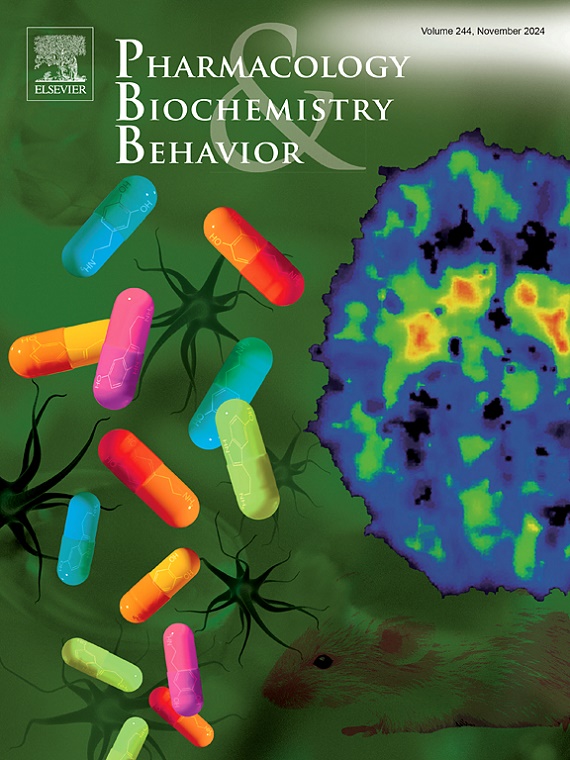Repeated 5-HT6 receptor activation facilitates flexible behavior in C57BL/6J mice
IF 3.3
3区 心理学
Q1 BEHAVIORAL SCIENCES
引用次数: 0
Abstract
The serotonin (5-HT) 6 receptor has recently emerged as a novel target for the treatment of cognitive deficits seen in known neuropsychiatric disorders. While much of the research has concentrated on understanding the therapeutic effects of 5-HT6 receptor antagonists, much less is known regarding the behavioral impact of 5-HT6 agonist treatment. The current study examined the impact of 5-HT6 receptor partial agonist EMD 386088 on behavioral flexibility in an operant probabilistic reversal learning paradigm. Female and male C57BL/6J mice were trained on an 80 %/20 % probabilistic discrimination task until the learning criterion was reached. As predicted, mice did not differ in trials or days to reach criterion during this initial acquisition phase. Once the learning criterion was met, the probabilistic 80 %/20 % contingencies were reversed. Mice received EMD 386088 (1 or 5 mg/kg) or vehicle control administration before each reversal learning session. Mice treated with 1 mg/kg EMD 386088 took significantly fewer trials to reach reversal learning criterion compared to controls. Conversely, the 5 mg/kg dosage did not affect trials or days to reach reversal criterion. While EMD 386088 treated female mice tended to display enhanced reversal learning, there were no significant sex differences. Enhanced reversal learning in the 1 mg/kg group coincided with an increase in the probability of win-stay behavior compared to controls. Thus, the 1.0 mg/kg dose of EMD 386088 may lead to an increase the animals' sensitivity to the reinforced trials during learning. These findings highlight the benefits of repeated 5-HT6 receptor activation on facilitating behavioral flexibility.
5-HT6受体的重复激活促进了C57BL/6J小鼠的灵活行为。
5-羟色胺(5-HT) 6受体最近成为治疗已知神经精神疾病中认知缺陷的新靶点。虽然大部分研究都集中在了解5-HT6受体拮抗剂的治疗效果,但对5-HT6受体拮抗剂治疗的行为影响知之甚少。本研究考察了5-HT6受体部分激动剂EMD 386088对操作性概率反转学习范式中行为灵活性的影响。雌性和雄性C57BL/6J小鼠进行80 %/20 %的概率辨别任务训练,直到达到学习标准。正如预测的那样,在最初的获取阶段,小鼠在试验或达到标准的时间上没有差异。一旦满足学习标准,概率80 %/20 %偶然性被逆转。小鼠在每次反转学习前分别给予EMD 386088(1或5 mg/kg)或小鼠对照。与对照组相比,1 mg/kg EMD 386088治疗小鼠达到逆转学习标准的试验次数显著减少。相反,5 mg/kg剂量不影响试验或达到逆转标准的天数。虽然EMD 386088处理的雌性小鼠倾向于表现出增强的反向学习,但性别差异不显著。与对照组相比,1 mg/kg组的逆转学习增强与赢-停留行为的概率增加相一致。因此,1.0 mg/kg剂量的EMD 386088可能导致动物在学习过程中对强化试验的敏感性增加。这些发现强调了重复激活5-HT6受体对促进行为灵活性的好处。
本文章由计算机程序翻译,如有差异,请以英文原文为准。
求助全文
约1分钟内获得全文
求助全文
来源期刊
CiteScore
6.40
自引率
2.80%
发文量
122
审稿时长
38 days
期刊介绍:
Pharmacology Biochemistry & Behavior publishes original reports in the areas of pharmacology and biochemistry in which the primary emphasis and theoretical context are behavioral. Contributions may involve clinical, preclinical, or basic research. Purely biochemical or toxicology studies will not be published. Papers describing the behavioral effects of novel drugs in models of psychiatric, neurological and cognitive disorders, and central pain must include a positive control unless the paper is on a disease where such a drug is not available yet. Papers focusing on physiological processes (e.g., peripheral pain mechanisms, body temperature regulation, seizure activity) are not accepted as we would like to retain the focus of Pharmacology Biochemistry & Behavior on behavior and its interaction with the biochemistry and neurochemistry of the central nervous system. Papers describing the effects of plant materials are generally not considered, unless the active ingredients are studied, the extraction method is well described, the doses tested are known, and clear and definite experimental evidence on the mechanism of action of the active ingredients is provided.

 求助内容:
求助内容: 应助结果提醒方式:
应助结果提醒方式:


